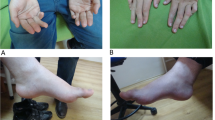Abstract
Hereditary spastic paraplegia with thin corpus callosum (HSP-TCC) is one of the most common complicated forms of autosomal recessive hereditary spastic paraplegia (HSP). Mutation in SPG11 gene, which is mapped to chromosome 15q21, was recently found to be a major cause of this variant form of HSP. The aim of this study is to investigate SPG11 mutations and clinical manifestations in two Korean families with HSP-TCC. Direct sequencing of the 40 coding exons and boundaries of exon–intron in SPG11 gene, and descriptions of clinical findings in two nonconsanguineous families with HSP-TCC are presented. Three novel and one known compound heterozygous mutations were found in two affected families, which were not found in controls, including one deletion in exon (c.5410_5411delTG), two insertions (c.1834_1835InsT and c.2163_2164InsT), and one missense mutation (c.3291+1G>T). Both of our patients had impairments in frontal lobe functions. We present the first SPG11 mutations in Korean families, three of which are novel. SPG11 mutation should be suspected in Korean patients having HSP with TCC and executive dysfunction.


Similar content being viewed by others
References
Paisan-Ruiz C, Dogu O, Yilmaz A et al (2008) SPG11 mutations are common in familial cases of complicated hereditary spastic paraplegia. Neurology 70:1384–1389. doi:10.1212/01.wnl.0000294327.66106.3d
Stevanin G, Santorelli F, Azzedine H et al (2007) Mutations in SPG11, encoding spatacsin, are a major cause of spastic paraplegia with thin corpus callosum. Nat Genet 39:366–372. doi:10.1038/ng1980
Stevanin G, Azzedine H, Denora P et al (2008) Mutations in SPG11 are frequent in autosomal recessive spastic paraplegia with corpus callosum, cognitive decline and lower motor neuron degeneration. Brain 131:772–784. doi:10.1093/brain/awm293
Zhang SS, Chen Q, Chen XP et al (2008) Two novel mutations in the SPG11 gene causing hereditary spastic paraplegia associated with thin corpus callosum. Mov Disord 23:917–919. doi:10.1002/mds.21942
Slachevsky A, Villalpando J, Sarazin M et al (2004) Frontal assessment battery and differential diagnosis of frontotemporal dementia and Alzheimer disease. Arch Neurol 61:1104–1107. doi:10.1001/archneur.61.7.1104
Weintraub S (2000) Neuropsychological assessment of mental state. In: Mesulam MM (ed) Principles of behavioral and cognitive neurology. Oxford University Press Inc., New York, pp 129–149
Mathuranth PS, Nester PJ, Berrios GE et al (2000) A brief cognitive test battery to differentiate Alzheimer’s disease and frontotemporal dementia. Neurology 55:1613–1620
Samaranchi L, Riverol M, Masdeu J et al (2008) SPG11 compound mutations in spastic paraparesis with thin corpus callosum. Neurology 71:332–336. doi:10.1212/01.wnl.0000319646.23052.d1
Depienne C, Stevanin G, Brice A et al (2007) Hereditary spastic paraplegias: an update. Curr Opin Neurol 20:674–680. doi:10.1097/WCO.0b013e3282f190ba
Liao SS, Shen L, Du J et al (2008) Novel mutations of the SPG11 gene in hereditary spastic paraplegia with thin corpus callosum. J Neurol Sci 275:92–99. doi:10.1016/j.jns.2008.07.038
Denora PS, Schlesinger D, Casali C et al (2009) Screening of ARHSP-TCC patients expands the spectrum of SPG11 mutations and includes a large scale gene deletion. Hum Mutat 30(3):E500–E519. doi:10.1002/humu.20945
Shibasaki Y, Tanaka H, Iwabuchi K et al (2000) Linkage of autosomal recessive hereditary spastic paraplegia with mental impairment and thin corpus callosum to chromosome 15A13–15. Ann Neurol 48:108–112. doi:10.1002/1531-8249(200007)48:1<108::AID-ANA17>3.0.CO;2-A
Acknowledgment
This work was supported by Grant No. A091226 from Korean Ministry for health welfare and family affairs funds.
Author information
Authors and Affiliations
Corresponding author
Electronic supplementary material
Below is the link to the electronic supplementary material.
Rights and permissions
About this article
Cite this article
Kim, SM., Lee, JS., Kim, S. et al. Novel compound heterozygous mutations of the SPG11 gene in Korean families with hereditary spastic paraplegia with thin corpus callosum. J Neurol 256, 1714–1718 (2009). https://doi.org/10.1007/s00415-009-5189-0
Received:
Revised:
Accepted:
Published:
Issue Date:
DOI: https://doi.org/10.1007/s00415-009-5189-0




